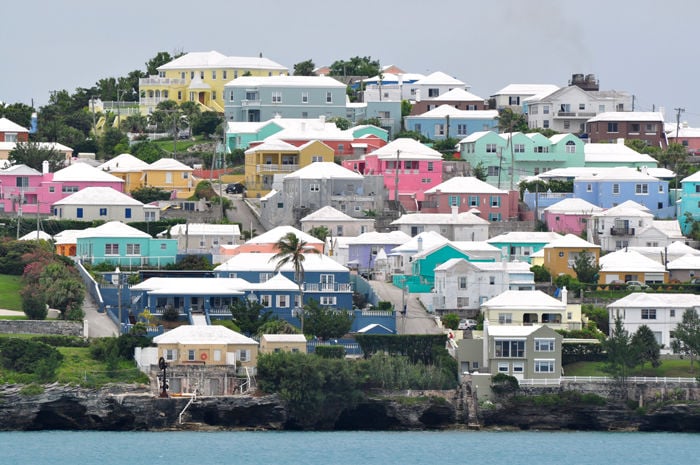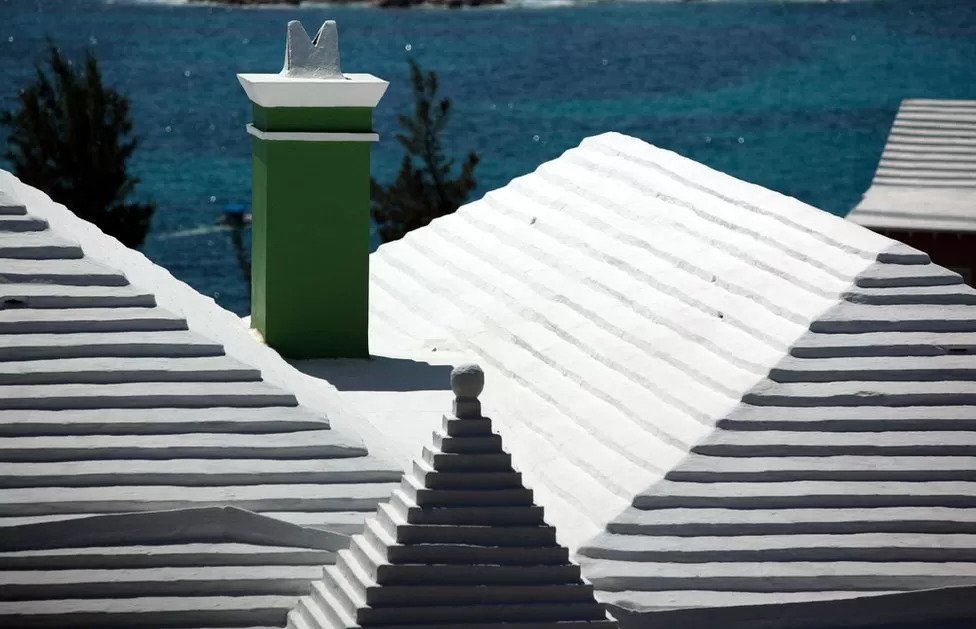Why Bermuda’s Roofs All Look The Same

Pictured above is a photo of some houses in Bermuda (via here), an idyllic island nation in the North Atlantic Ocean. The pastel-colored walls are what probably catch your eye — beautiful, right? — but let’s today focus on the roofs. They’re all basically the same, and that’s not an accident. It’s a survival trait.
Bermuda, being an island, is surrounded by water. But the water, as anyone who watched a young Ben Ben Affleck in Voyage of the Mimi in eighth-grade science can tell you, isn’t good for us humans to drink. For those who didn’t, though, the American Museum of Natural History can explain it: “If you drank seawater, the salt would get absorbed into your blood along with the water. That would make your blood too salty. So, your kidneys would have to remove the salt. But to do that they would need to use even more water! That’s why drinking seawater would just make you thirstier. It can even make you sick if you drink it too often.” Bermudans, therefore, need to find another source for their drinking water.
And unfortunately, there isn’t one to be found — at least not permanently. There are no freshwater rivers, lakes, or streams across the entire island. The only source of drinkable water comes from the sky.
Which is why the roofs are the way they are. Bermuda has huge amounts of limestone deposits, and therefore, limestone is a relatively inexpensive option if you’re looking to build a house. It’s a resilient building material that holds up well in hurricanes, which is important when you’re out there in the middle of the Atlantic Ocean. Most if not all of the homes seen above are made from limestone — including the roofs. But the roofs do more than just resist storms. They also turn that weather into drinking water. As seen below, via the BBC, the roofs are built with a step-like pattern which, as the BBC explains “are designed this way to harvest rain. The steps slow down heavy rainfall helping the gutters to collect the water and store it in a tank under the house.”

For an area without access to freshwater through other means, the roofs are a good idea. Oh, and they’re the law. If you want to build a new building in Bermuda, the Bermuda Roofs, as they’re called, are part of the mandated process. As of 2022, according to the Bermudian, “there are strict regulations in our building code that dictate both the water catching ratio for each roof (80%) and a minimum tank size per roof area (eight gallons per square foot).” Each house is responsible for its own water needs, although in recent years, society-level desalination efforts have supplemented the roof-to-cistern systems.
But the roof collection system has been around for so long, it is ingrained in Bermudan culture — and celebrated. Per the above-linked Bermudian article, the roofs are “so important [ . . . ] that it has its own ceremony – the ‘Roof Wetting.’ This is a time-honored tradition for newly constructed buildings that involves the contractor, the architect, some family members and/or dignitaries, ascending a ladder with a fresh bottle of Gosling’s Black Seal Rum, of which a splash is poured onto the new roof and another down the throat of the participants. That’s right, here in Bermuda we climb ladders onto our rooves and drink rum straight from the bottle.” Drinkable water, after all, is worth celebrating.
Bonus fact: Bermuda’s coat of arms explains why anyone would want to colonize an island without any persistent fresh water. As seen here, the coat of arms features a wrecked ship. The image is a reference to the Sea Venture, a ship that left England in 1609 on a supply run to the Jamestown settlement in modern-day Virginia. The Sea Venture didn’t make it to the future United States; it struck a leak and crashed into what is now Bermuda. Those that survived set up camp on the island, built two new ships out of trees they found there, and ultimately made their way to Jamestown. Some, however, returned to Bermuda afterward, establishing a permanent colony on the island.
From the Archives: Mr. Happy Man: The story of a happy man in Bermuda, who sadly passed away in 2016. (The story I wrote about him was from 2014.)
